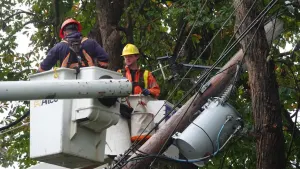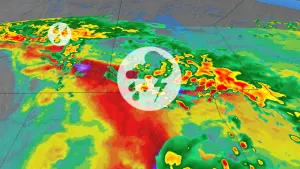
Prairie farmer sees the impacts of wildfire smoke on her crop production
Smoke from Alberta's wildfires has farmers worried as the harvest season takes over the Prairies.
Christi Friesen, a grain farmer in the province's Peace region, told CBC's Edmonton AM that smoke has been an ongoing issue over the past few years.
"In 2019, we had pretty bad wildfires up north here that actually blocked out the smoke for a week, and it made our crops stagnant," Friesen said.
"It didn't grow, it didn't mature, it didn't do anything for about a week."
RELATED: Affected by smoke this year? Plants and animals have been too, experts say
And this year's dry conditions and heavy smoke in the air is making her more cautious in the ever-changing climate.
She said there are patches of green in her canola fields where the plant isn't able to mature properly.

(NASA)
"As the canola plant gets larger they need a lot more sunlight to photosynthesize," she said.
Smoke impacts on plants
Linda Gorim, an assistant professor at the University of Alberta and the Western Grains Research Foundation Chair in Cropping Systems, said the impact of smoke on crop production really depends on how far the crops are from the smoke.
"Smoke blocking rays from reaching your crop is going to interfere with photosynthesis," Gorim said.
Small openings on leaves called stomata are involved in the process of photosynthesis — which is a way to store the sun's energy as food for the plant to use later.
If light is not available, then photosynthesis will be reduced by up to 50 per cent, said Gorim.
"The only problem with smoke is that smoke is not just carbon dioxide that the plant can use for photosynthesis," she said.
WATCH: Wildfire smoke a stark reality for these Western Canada weddings
"Most of the time it will also have some volatile organic compounds and these volatile organic compounds would combine with nitrogen dioxide in the air and produce ozone."
Ozone is just as dangerous for plants as it is for humans, Gorim said. If absorbed, ozone can destroy chlorophyll and impact crop production.
But smoke doesn't just create a haze, Gorim said it can also fracture light into reflections.
"When it fractures light, then you would have dispersed light in the atmosphere," Gorim said. "Then you have some red and green or blue spectrum of light and that is very good for photosynthesis."
She said when that happens, the plant canopy should be able to photosynthesize more.
If the crop is closer to the smoke source farmers would also have to be mindful of ash settling on their crops.
Ash can settle on the plants and block the stomata pores, which will destroy the network of gas going out of the plant and the carbon dioxide that is being absorbed.
WATCH: Canadian wildfire smoke reaches all the way to Greenland
Determining the actual impact that wildfire smoke can have on crops is hard Gorim said, with many factors involved.
"We do not have any research that is addressing the impact of ash or smoke on crop production," she said. "All of this is coming from other parts of the world, mostly from the U.S."
She said she hopes someone will attempt to research the impact of ozone because it affects human health, too, not just plants.
Thumbnail courtesy of Linda Gorim/Dawn Graves via CBC.
The story was originally written by Ishita Verma and published for CBC News.









